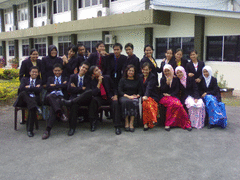Reflection on Topic 3: Morphology
Reflection on Topic 3: Morphology
After studying on about this topic, I have understood that morpheme is actually one of three part of the grammatical knowledge of language. It is the minimal unit of grammatical analysis/ function. All words are morphemes or combinations of morphemes. Based on what I have learned, monomorphemic words have one morpheme, dimorphemic words have two morphemes and polymorphemic words have more than one morpheme.
There are 5 types of morpheme which are
- · free morphemes
- · Bound morphemes
- · Inflectional morphemes
- · Derivational morphemes
- · Allomorphs
Free morpheme is a word or morpheme that can stand on its own and has a grammatical function. E.g is play is a basic morpheme which can occur on its own and has a grammatical function as an adjective. For bound morpheme, it is opposite of the free morpheme where it can’t stand by its own. For example is word un+identify. The word un can’t stand by its own.
An inflectional morpheme is an affix used to change form and function only from the grammatical point with no change in part of speech of the word. In example is the word play. The meaning didn’t change if we add inflectional morpheme for the word plays, played and playing. The opposite of inflectional morpheme is derivational morpheme. This type of morpheme can be used to make further new words and change the meaning of the words. The examples are as follows:
- · Sing+er
- · Bad+ly
- · Graceful+ly
- · Un+do
- · Mis+take
The last one is allomorph. The [s] morpheme in English which indicates plurality or third person singular present tense has 3 variants of allomorphs /s/, /z/ and /ᵊ z/. For past tense, the 3 allomorphs are the sound /t/, /d/ and /Ι d/. Other types of allomorphs are also the result of lexical conditioning, where it happens also in past tense. Examples are eat become ate, sing become sang and etc. The last part of allomorphs that I understand for this topic is the zero allomorphs. It is the term given to the unit involved when a morpheme changes status from one type of morpheme to another without any addition or subtraction of its parts. It also includes some words that show no change in masculine or feminine gender for example fish, ants, bear and etc.
From this topic, we had also learned about word structure and how morpheme build into words and then form a phrase. After we had gone through all of these, I had realize how important grammar for English teacher like us. I also understand that English is a very sensitive language where every change of the root word from example adding affixation will make the meaning of the word will change from the root word after we had learned about word formation process. For me, as a teacher, we should be the role model for the students. Excellent English usage in the class is very important. This subject gives me opportunity to improve my grammar.
For the ISL this week, we are required to do games related to this topic. So, my group had decided to do this games using action, in other words, students will guess the action that their friends act out and add any suitable affixation to the words. The groups that can modify the root word accurately and can produce more words are the winners. From this activity, the children can improve their vocabulary.
I also understand that as a teacher, we should try to make the students attracted to study English where students can play and learn at the same time. This will make learning English will be more fun and students will love English and did not feel that it is difficult to learn.
Miming
Actor:
Saiful Azali Hamdan as the doctor
Mohd Sabri as the patient
Scene 1
Doctor : Please have a seat.(hands action to show have a seat)
Patient : Thank you Doctor.(nod the head and smile)
Doctor : What brings you here?(Facial expression to show asking action)
Patient : I have a runny nose, doctor.(point to self, then point to nose and make running action)
Doctor : take this pill(showing action by taking a pill from a pocket and give it to the patient)
Patient:: (making action by swallowing the pill and happy face as if already cured.)
Actor:
Nurain as the waitress
Natalia as the customer
Scene 2
Waitress : Hello, what you would like to order?(making smiley face, eating and drinking action)
Customer : I would like to order Roti Canai please.(Do an action of roti canai making)
And cold Teh Tarik.(Do the teh tarik making action, and then freezing action)
Waitress : Ok, wait for a minute.(Do a running action to the kitchen and start making the order. After that, make an action to serve the customer her order.)
Customer : Wow! this Roti Canai is so delicious! And This Teh Tarik is very tasty!(make a happy action after eating and drinking.)
Waitress : (very happy with the praise and being a little proud)
Customer : Fuuh! I am really full. How much all of this?(make a full-stomach action, and money asking action)
Waitress : (take a receipt from the pocket)
Customer : (very shocked!!)
Homemade by:
Natalia,Nurain,Sabri,Saiful
PPRMT 5 (2011)
TONGUE TWISTER
TONGUE TWISTER
HOMEMADE BY
- SAIFUL AZALI
- MOHD SABRI
- NATALIA
- NURAIN
WHAT IS TONGUE TWISTER
- Combinations of alliteration (repetition of a sound)
- A phrase design-made very easy to slip accidentally.
- Spoonerism- words or phrases in which letters or syllables get swapped
— Tease my ears (Ease my tears)
— A lack of pies (A pack of lies)
Simple Tongue Twister
How many cans can a canner can, if a canner can can cans?
A canner can can as many cans as a canner can, if a canner can can cans.
Normal Tongue Twister
A flea and fly in a flue,
Were imprisoned so what could they do?
Said the flea let us fly.
Said the fly let us flee.
So they flew through a flaw in the flue.
Harder Tongue Twister
You've no need to light a night-light
On a light night like tonight,
For a night-light's light's a slight light,
And tonight's a night that's light.
When a night's light, like tonight's light,
It is really not quite right
To light night-lights with their slight lights
On a light night like tonight.
REFERENCES
- http://www.alphadictionary.com/fun/tongue-twisters/english_tongue_twisters.html
- http://www.fun-with-words.com/tong_explain.html
- http://www.fun-with-words.com/spoonerisms.html
- http://www.indianchild.com/tongue_twisters.htm
Reflection Topic 2: Introduction to phonology
For this topic, we had study about speech organ and English sounds. Now I have understood three important parts in this topic which are phonetics, phonetic script and phonemes. Phonetics is the study of sounds made by humans when they talk while the phonemes are the smallest unit of sound in a language which carries distinctive meaning.
The most important part that I learn in this topic is the speech organ involved when we produced sounds to make a speech. There are 15 speech organs were involved when we speak. If one of our speech organ did not function well, it will absolutely affects our speech. For example is if we don't have front teeth, then, it will be very difficult for us to say words with s.
http://www.barcode.ro/tutorials/biometrics/img/speech-production.jpg
From the speech organs, we can produce 3 sounds which are initiation, phonation and articulation.
| Speech production | Description |
| Initiation | · The production of any speech sound requires the creation of an air stream in vocal tract. Te air stream is initiated by the lungs |
| Phonation | · As the airstream passes through the larynx, it is modified by the vocal cords, through the introduction of voice. · When the vocal cords are brought together, airs passing out of the lungs cause them to vibrate and voice is produced. If the vocal cords are pulled back, they cannot vibrate. These sounds are called voiceless. |
| Articulation | · As the air stream passes through the vocal tract, it may be modified by the movement of the active articulators obstructing its passage through the vocal tract to varying degrees. · The obstruction of the air stream may occur at any point in the point in the vocal tract and is the result of the active articulators moving towards a passive articulator |
English sounds can be divided into two parts, vowel/diphthong sounds and consonant sounds.
Consonant can be divided into two parts, voice consonants and voiceless consonants. Voiced consonants are produced when the vocal cords are held tightly so that the air stream vibrates them. But for voiceless consonants, there is no vibration at the vocal cords.
For vowels, it is actually a sound without detectable change in quality from beginning to end. It results from changing the shape and the position of tongue and lips. The sounds are produced here there is no friction or stoppage of air. Vowels can also be divided into two types which are simple vowels/ monophthongs and diphthongs.
For our activity in ISL, we had done minimal pairs tongue twister. We had gone through so much obstacles while selecting the tongue twister and doing the minimal pairs for initial, medial and final. as for me, it is not easy to find the correct words for three categories of the minimal pairs where we have to refer to the dictionary for so many times to make sure that the answer is correct.
While learning all of this, I have realized how importance the pronunciations in English are. As a teacher, it is very important to be a good role models for pronunciation because children learn pronunciation by imitation.






























